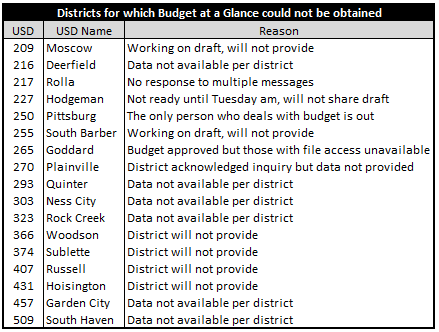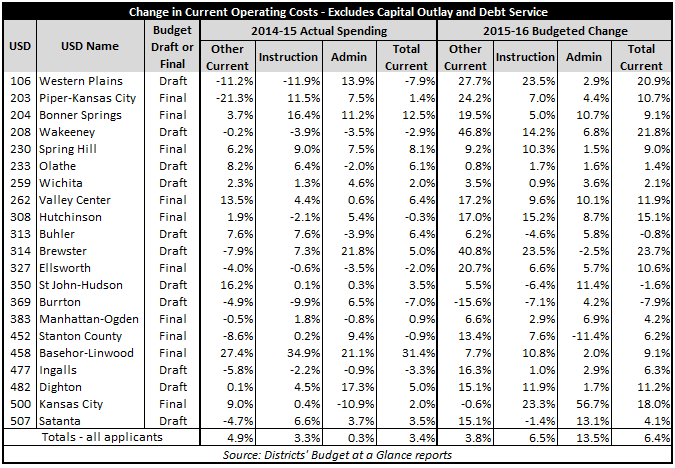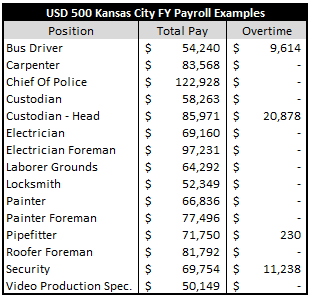Thirty-eight school districts have applied for additional state aid from the Extraordinary Needs fund based on increased enrollment, reduced property values, loss of state aid (just Hutchinson) and the reactivation of two refugee resettlement agencies in Wichita by the U.S. Office for Refugee Resettlement. The State Finance Council will decide whether – or the extent to which – each case merits additional funding from state taxpayers.
Several members of the Finance Council asked the applicants to provide information about steps taken to make their district operate more efficiently, to which some school districts, legislators and media responded with various forms of criticism. Asking taxpayer-funded entities whether they are operating efficiently is a perfectly legitimate question that, frankly, should be the starting point of every budget discussion; that some find it offensive is indication that the issue should be much more aggressively pursued across government.

Kansas Policy Institute gathered the following data to help citizens make their own determinations, and even more information is available in our 2015 Public Education Fact Book. We requested a copy of each applicant’s Budget at a Glance for the current year from those who didn’t already have it posted to their web site in order to compare their current year budget with actual spending from prior years. We were only able to collect data on 21 of the 38 districts; remarkably, 8 applicants said their budget wasn’t finalized so the data wasn’t available. Seven applicants had the data but five of them would not provide it and two said they couldn’t provide it because those with access were away from the district. We were unable to get a response from the other two.
Some interesting information is found in the data shared by the 21 applicants, including:
- 17 districts are budgeting more than an inflationary increase
- 9 districts are budgeting more than a 10% increase
- 10 districts plan to increase Administration more than Instruction

Complete information on the applicants that provided information (dollar amounts by category including Capital, Debt Service and Total) can be downloaded here. The spreadsheet also shows the amounts each district received in block grant-equivalent funding for FY 2014 and the amounts for FY 2015 through FY 2017 as calculated by the Department of Education.

Kansas City’s 57% increase in Administration amounts to $15.7 million, which is ironically about the same amount that applicants are collectively requesting in Extraordinary Needs funding. A Legislative Post Audit efficiency study conducted in 2013 found that Kansas City was paying well above market for many positions and it appears that that may still be true.
The adjacent table is a sampling from the district’s payroll listing for the 2015 school year obtained through an Open Records request. Work of this nature could be outsourced at much better prices, with the savings made available for Instruction.
Kansas City may be somewhat of an extreme example but it is very common for districts to have work performed by district employees that could be more efficiently outsourced. This is just one example of valid questions that should be asked of districts that are requesting additional aid.
Allocation of resources to teaching and non-teaching positions would be another valid line of inquiry. Classroom teacher employment over the last ten years has outpaced enrollment in many cases and non-teacher employment has grown even faster. This is not to say that the relationship should be the same in every case, as there are a number of legitimate reasons for some degree of variance. But the raw data – available here – allows for additional benchmarking that indicates opportunities more efficient staffing levels.

It would also be pertinent to ask applicants whether they provide lucrative payouts to employees who terminate or retire. The Blue Valley superintendent received a one-time payment for deferred compensation of $328,591 last year; the cost of that alone is significant but it could alsodramatically increase his pension…for life. The Shawnee Mission Assistant Superintendent collected $132,614 for unused sick leave and vacation upon retirement and could also collect additional pension as a result. Kansas City told us that the position of Chief Human Resources Officer was eliminated but his contract had to be paid out, which accounts for the large increase last year.
Local school boards make these decisions to provide lucrative payouts but taxpayers all across Kansas pick up part of the tab, as there is no separation between what is paid with state and local tax dollars on items of this nature.
School districts may have made some spending adjustments but they are still organized and operating rather inefficiently according to Legislative Post Audit and other information. It would be appropriate for any grant of extraordinary aid to be conditional upon a commitment to implement substantive measures to implement specific operating efficiencies, including outsourcing to regional service centers and the private sector as appropriate.




